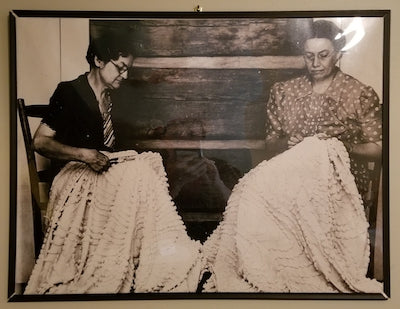
All About Chenille - a Book Review and a Handbag Upgrade
I recently read the fun and informative "Southern Tufts: The Regional Origins and National Craze for Chenille Fashion," by Ashley Callahan. The book gives an in-depth account of the chenille industry, which began here in the southeastern U.S. in Dalton, Georgia.

I first learned of the book when Mr. BDV and I toured the historic homes and commercial buildings of Dalton (an hour-and-a-half north of Atlanta) with The Georgia Trust for Historic Preservation.
I snapped the photos collaged below at the 1840 Hamilton House, home to the Whitfield-Murray (County) Historical Society and at the Bandy Heritage Center, which occupies an old train depot. Both museums are chock full of information about, and fine examples of, locally made chenille.
Reviving a colonial-era craft, enterprising depression-era women hand-tufted cotton bedspreads on their front porches. They enlisted friends and neighbors to share the labor and reap the profits.
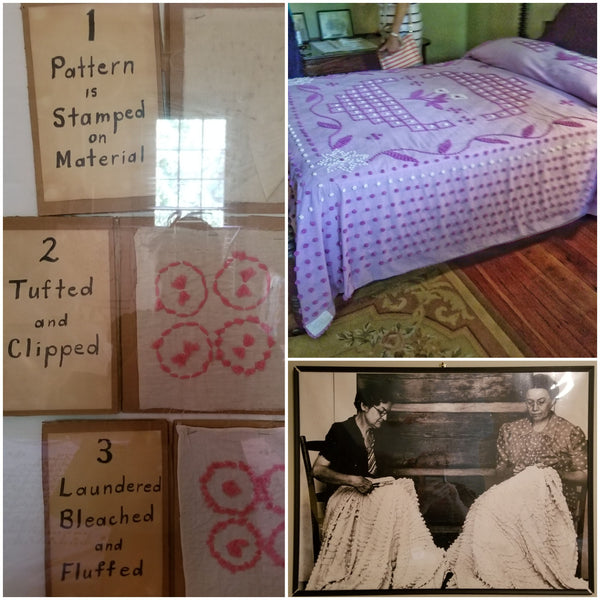
Strung on clotheslines, their colorful wares captured the eyes and hearts of tourists "rollin' down highway 41" -- the main drag between chilly northern states and always sunny Florida to the south. Peacocks were the most popular motif, and this stretch of road became known as "Peacock Alley."
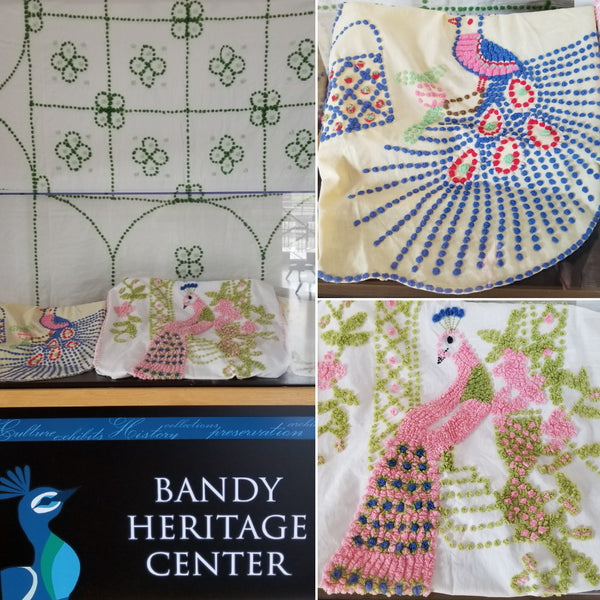
By the 1950s, when the new interstate highway system redirected traffic away from small towns, the long-wearing, oddly bumpy, comfortably soft spreads, robes, and other tufted items had become a national craze that was already waning.
Individually hand-tufted pieces still existed. But the industry was now a large-scale operation, churning out machine-made chenille fabric by the mile and employing thousands in mills and factories across the region.
Dalton's Crown Mill, next door to the historical society, is a typical example.
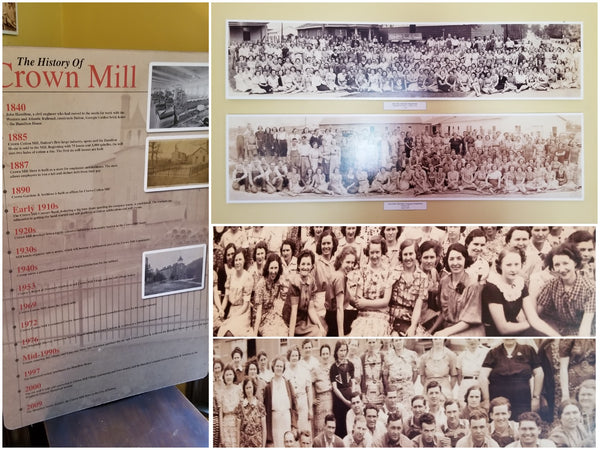
Today it's an attractive mixed-use development of residential and retail space.
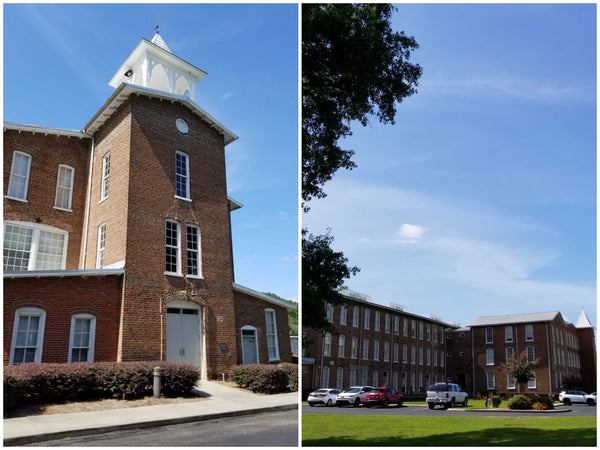
The store for mill employees, situated right across the street, is still up for grabs. Wouldn't it make a wonderful watering hole/gathering spot? Who wants to go in with me to open a pub called The Company Store? The logo would, of course, have to include a crown.
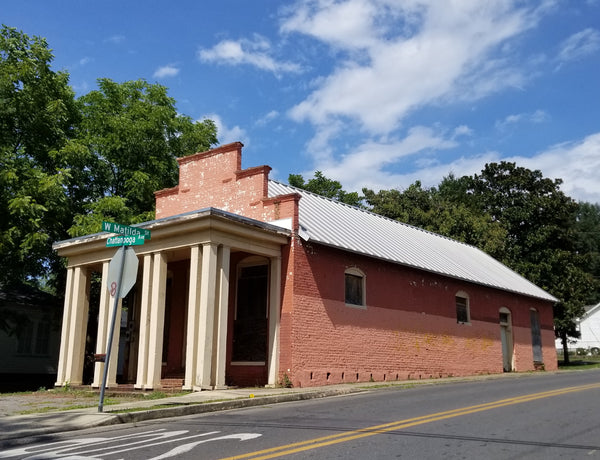
Eventually, the chenille fad faded (as all fads do). But that wasn't the end of Dalton. Even as chenille went from chic to dowdy, resourceful entrepreneurs adapted all that chenille-making equipment to make carpet (another "tufted textile"). To this day, Dalton remains the carpet capital of the world.
"Southern Tufts" outlines this entire history and Callahan includes images of an array of vintage chenille clothing. These splendidly strange c. 1940 pants were personal favorites. Don't they look comfy and a bit crazy? Can't decide which pair I prefer. Thanks to Lizzie, who's borrowing the book, for the photo:

Callahan describes in detail the process of hand-tufting and how it was scaled up for mass production. She provides histories for what appears to be every chenille industry enterprise that ever existed, with longer, more complete profiles of some of the biggest and most famous players.
In the Dalton museums, Mr. BDV and I saw a variety of original examples (though no wacky trousers), as well as original equipment and ephemera from the local mill.
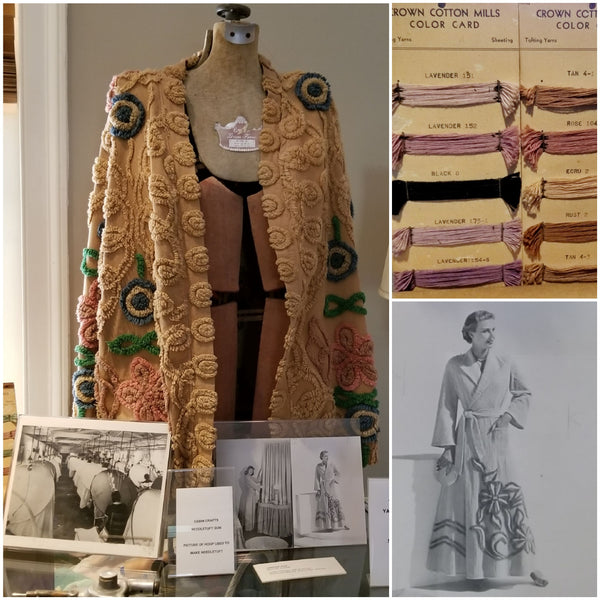
Lizzie has several examples in her outstanding collection of women's historic sports and leisure wear, and you can see photos here, in her own review.
Soon after finishing the book, I found this small chenille drawstring purse in an antiques shop. Reading glasses are for scale.

It's from the 1990s, so doesn't count as vintage by my rules, but it was $6 and is made of cotton, so I bought it.
Callahan's book told me that Damze was the post-1989 iteration of DMZ, a company founded in 1980 by Debra Maria Zomparelli. She'd made fashionable jackets from vintage chenille spreads, eventually turning to surviving Georgia manufacturer Soft Goods for a reliable source of quality tufted textile.
The bag looks to be made of scraps, which could certainly be the case. Back when, both enterprising individuals and big companies fashioned bedroom slippers, plush toys, and other small items from the pieces left over after robes and other larger items were cut. Waste not, want not.
But scroll back and look at that awful, cheap-looking drawstring. It had to go. Trips to my mega-fabric place, two national chains (the one I call "Fleece and Intolerance" and Joanns), and a pricey local shop netted me only kinda maybe ok twisted cord. But then Lizzie sent some cotton rope-like stuff that was a perfect match.

The rope-like thing was the clear winner. It could hardly be more perfect.
After snipping and discarding the hideous original, I tried (and tried) to thread the new rope through. I can't believe how long I kept at it. I managed one loop, but there was no way to get both loops through. A shame, because size-wise, it actually looked quite good.
Eventually, I did as Lizzie advised and just kind of split the thing in half. The resulting slimmer rope threaded through fairly easily, and here's the happy result. Much better, no? Thanks, Lizzie!
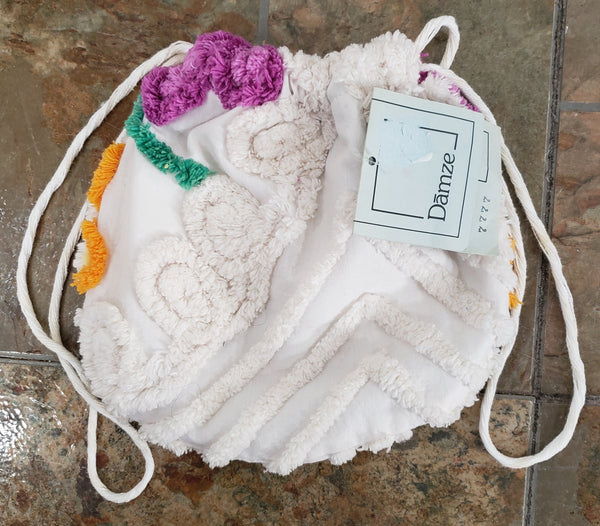
Full disclosure, I'm not a huge fan of chenille. I never liked the robes and I can do without the bedspreads. But learning the history of the industry and visiting its epicenter has softened me on it a bit. Enough to carry a little purse in tribute, if not wrap myself head to toe.
Now I just have to work up the... what, exactly? ... to snip off the original hangtags. It's not even real vintage, but so far I can't bring myself to do it. I only wish this little bag were tote size. How cool would that be? As is, I think it will coordinate nicely with my 30s beach pajamas.

